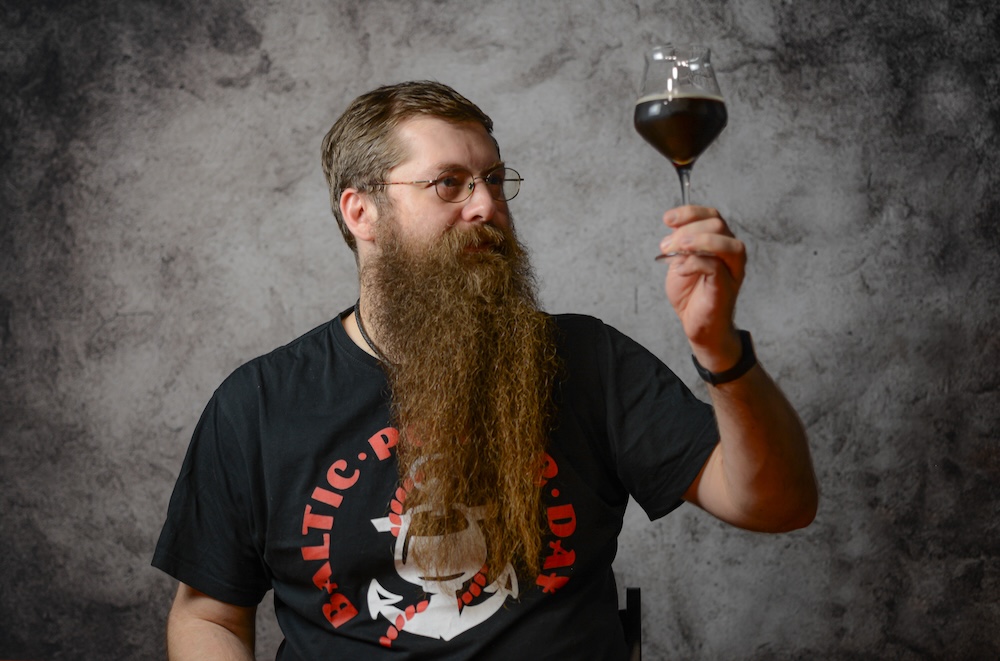Which Baltic porter is the best? The one you like!
Baltic porters range from very rich and sweet, to balanced and treacherously drinkable, to dry and bitter. Of course, they will all have some common characteristics. Each beer in this style will be dark and strong, with notes of chocolate, caramel, coffee, dried fruit. But how do you find your way through the maze of different porters to get to the tastiest one? If you are new to Baltic porters, you might want to start with the lighter, more approachable versions. Pay attention to the parameters described on the bottle or can label. The original gravity/extract tells you how essential and rich the beer is – the more extract it has, the richer and denser it will be. It is a good idea to start with porters with a gravity of 18-19. This value can be expressed as a percentage in Blg or Plato degrees.
A good porter to start your adventure with the style might be the Grand Baltic Porter from Browar Amber. It is quite light for a porter, with 18.1% extract and 8% alcohol. It will give you everything a decent Baltic porter should have, it is well balanced and rich. If the porter has less than 18 degrees of extract, it is unlikely to be a true Baltic porter. It may be a tasty beer, but it will not have the characteristics of the style.
The most classic Baltic porters have 20-22 degrees of extract and 9-10% alcohol. You should look for the 652 m npm (652 m above sea level) from Browar Podgórz, a classic porter aged for a year before bottling. Then there are imperial Baltic porters, usually with an extract of 24-28. Among them, Latający Jeleń (Flying Deer) from Browar Kazimierz deserves a mention; it also won the prestigious Kraft Roku (Craft Beer of the Year) competition in 2023. There are also porters that are more full-bodied, or even freeze-distilled, which can have over 40 degrees of extract and over 20% alcohol. This constitute a serious challenge as these beers are very thick, rich and sweet. They are best enjoyed with friends, tasted in small quantities in a group of several people. An example of such a beer is Darkness My Friend from Browar Maryensztadt.
Apart from extract, what should you look for when choosing a Baltic porter? Beers in this style can be diverse – classic, with additives, barrel-aged, freeze-distilled, heavily hopped. You will find this information on the label, so it is worth taking a moment to read it.
If it is the classic version you are after, check to see if the brewery states the age on the label. If they do, it is usually a good sign, indicating that the brewery is taking the right approach to producing this beer. Baltic porter needs a much longer maturation time than light, pale beers – a few or even a dozen months – to get the right balance.
Baltic porter is a style that goes very well with various additives. Imagine if a certain ingredient would go well with dessert chocolate. If so, there is a good chance that it would also go well with Baltic porter.
An example would be chilli, which you will find in Grand Imperial Porter Chilli from Browar Amber. A slight spiciness is noticeable on the finish, but it does not dominate the beer, it just gives it a greater depth of flavour.
Baltic porters are often enriched with additives that have similar notes to beer. These will include dried fruit, coffee, cocoa, and chocolate. Finally, Baltic porters are sometimes brewed with the addition of smoked malt, which gives the beer smoky, campfire notes.
If you like stronger spirits such as whisky or bourbon, you can look for Baltic porters aged in barrels that have held these distillates. Such porters will have noticeable notes that are characteristic of the alcohol that had originally been in the barrel, such as flavours of vanilla and coconut in a bourbon-aged beer.
You can also find Baltic porters aged in red wine, cognac, rum and peated whisky barrels. Each barrel adds to the porter’s profile, although some can dominate it.
To enjoy a Baltic porter to the full, you need to pay attention to two things – the right temperature of the beer and the right glass for tasting it. Baltic porter tastes best at a temperature of no less than 12-14°C, where you can feel all its qualities in the best way. Baltic porter straight from the fridge may appear deficient and it will be difficult to sense all its nuances.
For stronger, denser versions, a slightly higher temperature, even 16°C, may be optimal. The ideal glass for Baltic porter would be a goblet, snifter or pokal, i.e. a tasting glass that tapers towards the top. It is best to fill such a glass no more than halfway, so that the beer can be stirred freely, releasing all the aromas it contains.

The author of the article is Marcin Chmielarz. Biologist by education, brewer by vocation.
He has been involved with beer as a hobby since 2010 and professionally since 2013. He knows the craft beer industry from almost every angle, as one of the first beer managers in Poland in a pub, as a bartender, as a brewer in a contract and stationary brewery, as a beer blogger and vlogger, as a salesman and as a customer advisor in a company supplying breweries. He has lectured at beer events, both for the general audience and specialist ones for brewers. Author of articles in the quarterly “Piwowar”. Creator of over 100 commercially available beers, including many highly acclaimed porters
Founder and creator of Baltic Porter Day – a celebration of Baltic porter. The biggest Baltic porter specialist in Poland (and maybe even in the world), although he does not mind other types of porter.
The KOCIOKWIK.TV channel, run by Marcin and his wife
BIBLIOGRAPHY:
You may find this interesting:
- Baltic porter – style description
- What is the alcohol content of Baltic porter?
- What is the original gravity/extract content of Baltic porter?
- What colour should Baltic porter be?
- What is the ideal serving temperature for Baltic porter?
- What does Baltic porter taste like?
- What is the grist for brewing porter?
- What are the flavour notes of Baltic porter?
- What is the carbonation level of Baltic porter?
- What ingredients should be included in the Baltic porter beer kit?

